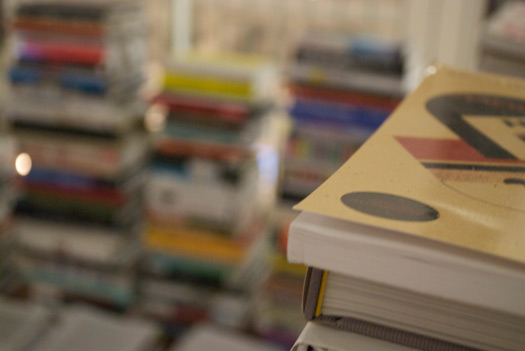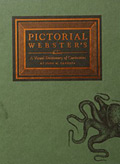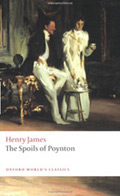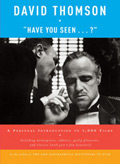
Photo by Malcolm Drenttel
For this holiday season, Design Observer's contributing writers offer some recommend-ations for gifts and personal reading.
Michael Bierut recommends:
Uta von Debschitz & Thilo von Debschitz
Springer, 2009
The amazing cutaway diagrams of German scientist, gynecologist and author Fritz Kahn (1888-1968) finally get their due in a new book. Do not miss this.
Springer, 2009
The amazing cutaway diagrams of German scientist, gynecologist and author Fritz Kahn (1888-1968) finally get their due in a new book. Do not miss this.
Andrew Blauvelt recommends:
Michael Rock, Susan Sellers & Georgianna Stout
New York: 2x4
It was USA Today's Sports Quote of 2004. Al Gore said it when the Supreme Court's gave George W. Bush the presidency. It is what it is: 1000 images. 1000 pages (excluding endpapers). Your choice of six book cover colors. 2.75 pounds. $45.
Riley Sharbonno & Monica Haller
Onestar Press/Falth & Hassler, 2009
Riley Sharbonno, a nurse at Abu Ghraib prison, photographed his daily experience using his camera to record the memories he would suppress. Artist Monica Haller offer
s us 480 pages of realities that provide a glimpse into a war the media ignores, that most Americans want to forget, but one that many of its combatants can't. In Matt Rezac's design, pages fit images and not the other way around, insuring that this book functions, like Riley's camera, as a concise repository of often traumatic experiences.
Hilar Stadler & Martino Stierli, editors
Verlag Scheidegger and Spiess, 2009
A collection of images from slides, photos, and films from the original field research of 1966-1968 that would form the visual core of Venturi, Brown, and Izenour's seminal analysis, Learning from Las Vegas (1972). Like the sun-bleached image of its cover, this book captures a fugitive moment in American culture with images that parallel and in some cases presage the deadpan aesthetic of artists such as Ed Ruscha and Dan Graham or the subjects of the new color photography as practiced by artists such as Stephen Shore.
Jade-Snow Carroll recommends:
Judith Lewis & David Ulin, editors
Designmatters at Art Center College of Design, 2009
Anything anyone could want to know about earthquakes: and not only L.A. earthquakes, but earthquakes in general. This book covers such topics as the myth of “earthquake weather,” to preparedness, to the art of living in perpetual denial of the inevitable. Created by the students and faculty of Art Center College of Design and designed by Stefan Sagmeister, it includes various essays and illustrations by many notables.
Harry Pearce
It Books, 2009
Using just one box per conundrum, two colors and a single typeface, Pentagram’s Harry Pearce has authored and designed a very entertaining book. Full of great visual puzzles, there is plenty of exercise for the brain, fun for the funny bone, and candy for the eyes. A very nice gift book indeed.
William Drenttel recommends:
Paul Auster
Henry Holt, 2009
This novel was panned by James Wood in The New Yorker ("Hints that have been scattered like mouse droppings lead us to the postmodern hole in the book where the rodent got in...") and praised by Clancy Martin in The New York Times Book Review ("So if, like me, part of why you read is the great pleasure of falling in love with a novel, then read Invisible."). I love Paul Auster's books, and this is definitely his best book in years. I loved all the "mouse droppings" in this dramatic story of incest and transformation...

This novel was panned by James Wood in The New Yorker ("Hints that have been scattered like mouse droppings lead us to the postmodern hole in the book where the rodent got in...") and praised by Clancy Martin in The New York Times Book Review ("So if, like me, part of why you read is the great pleasure of falling in love with a novel, then read Invisible."). I love Paul Auster's books, and this is definitely his best book in years. I loved all the "mouse droppings" in this dramatic story of incest and transformation...

John M. Carrera
Chronicle Books, 2009
The 1500 engravings that originally illustrated the 19th-century dictionaries of Noah Webster are a remarkably rich resource — one that lay buried in the bowels of Yale University. John Carrera has made an amazing book, collecting and restoring these illustrations from the original engravings. Collected together they tell a new story of knowledge, of nature, discoveries and innovations. A gem.
Jason Godfrey
Laurence King Publishing, 2009
A fundamental resource for graphic designers and teachers, Bibliographic surveys classic graphic design books with full-color large images. Since these books cannot be easily purchased, this thoughtful survey is a gem for book lovers.
Nader Vossoughian
NAi Publishers, 2008
Modern information design was invented in the same decades by Herbert Bayer and Otto Neurath, but there hasn't been a great monograph on the important work of the latter. This is it.
Michael Erard recommends:
Lydia Davis
Farrar, Straus and Giroux, 2009
A menagerie of (short) narrative forms; elegant and playful dispatches from a world that, refreshingly, seems to never have been visited by religion, brand names, or Freud. You'd call it science fiction, except there are no robots, either.
Andrei Molotiu, editor
Fantagraphics Books, 2009
Though "abstract comics" are (according to the editor) "sequential art consisting exclusively of abstract imagery" which may also "contain some representational elements as long as those elements do not cohere into a narrative or even into a unified narrative space," this arresting book is like a scoop of primordial narrative, representational mud. Which is to say, it has vitaminic powers.
Viktor Mayer-Schonberger
Princeton University Press
Looking for a dystopian notion for your sci-fi novel? Look no further. Mayer-Schönberger warns about the social and political costs and risks of ever-powerful, durable forms of memory prosthetics in the form of digital technologies, and proposes solutions.
Jessica Helfand recommends:
William Davies King
University of Chicago Press, 2008
Nearly everyone collects something, unless you're William Davies King, in which case you collect, well, pretty much everything — from broken bits of furniture to retro cereal boxes, his tales of aggregating so much stuff are at turns funny, poignant, deeply human and delightfully visual.
Christopher Payne
MIT Press, 2009
Beautifully researched, exquisitely photographed, expertly composed and edited, this book takes readers on an engrossing tour of abandoned state mental institutions across the nation. Though devoid of living souls, Asylum is every bit the portrait: it's a portrait of a lost generation, that reverberates with human tenderness on every page. Extraordinary.
Elizabeth Siegel
Art Institute of Chicago, 2009
Long before the Dada doings of Max Ernst and Kurt Schwitters, everyday people made spectacular compositions using silhouetted photographs and no shortage of colorful ephemera. The resulting photocollages, produced at the end of the Nineteenth Century, "reveal the educated minds as well as accomplished hands of their makers, as they take on new theories of evolution, the changing role of photography, and the strict conventions of aristocratic society."
Alexandra Lange recommends:
Christopher Alexander
Oxford University Press, 1977
An attempt to create a grammar of architecture that begins at the largest scale, regional transport, and ends with the smallest, the bedroom wall. In between, informed by a blend of common sense, Zen philosophy and quantitative measurement, Alexander and his colleagues develop a life-enhancing philosophy of building, drawn from that high-1970s source, sociological surveys. Always considered fairly far out, Alexander unexpectedly won the Vincent Scully Prize this year for the continuing influence of this book and The Timeless Way of Building.
Oxford University Press, 1977
An attempt to create a grammar of architecture that begins at the largest scale, regional transport, and ends with the smallest, the bedroom wall. In between, informed by a blend of common sense, Zen philosophy and quantitative measurement, Alexander and his colleagues develop a life-enhancing philosophy of building, drawn from that high-1970s source, sociological surveys. Always considered fairly far out, Alexander unexpectedly won the Vincent Scully Prize this year for the continuing influence of this book and The Timeless Way of Building.
Henry James
Oxford University Press, 2008
A slim novel about the danger of loving things more than family, more than romance, possibly more than life, in which alliances between mother and son, the tasteful and the philistine, the emotional and the reserved are created and destroyed over the question of what to do with Poynton — possibly the most beautiful house in England. A cautionary tale couched in James’s most exquisitely repressed language.
Oxford University Press, 2008
A slim novel about the danger of loving things more than family, more than romance, possibly more than life, in which alliances between mother and son, the tasteful and the philistine, the emotional and the reserved are created and destroyed over the question of what to do with Poynton — possibly the most beautiful house in England. A cautionary tale couched in James’s most exquisitely repressed language.
Michael Sorkin
Verso, 1994
Whenever I feel that contemporary architecture criticism has gotten too dull, I flip through this collection of Sorkin’s Village Voice reviews from the 1980s, pick one, and feel instantly refreshed. Sorkin can be mean (to Paul Goldberger) and paranoid (about the Ford Foundation), but his proto-snark is thoroughly backed up with architectural analysis that is both pointed and full of feeling.
Verso, 1994
Whenever I feel that contemporary architecture criticism has gotten too dull, I flip through this collection of Sorkin’s Village Voice reviews from the 1980s, pick one, and feel instantly refreshed. Sorkin can be mean (to Paul Goldberger) and paranoid (about the Ford Foundation), but his proto-snark is thoroughly backed up with architectural analysis that is both pointed and full of feeling.
Julie Lasky recommends:
Dave Eggers
McSweeney's, 2009
Set in New Orleans during Katrina, this nonfiction account of one man's harrowing ordeal in a city dissolving into toxic anarchy could have been unremittingly harsh and depressing, but it reads like a thriller. Very hard to put down.
Nancy Levinson recommends:
Bryan Bell & Katie Wakeford, editors
Metropolis Books, 2008
This upbeat compendium is a cross-section of public-interest design polemics and projects. The projects have low budgets and large ambitions, and include remediated riverways in Taiwan, microcredit-financed housing in Mexico, lightweight shelter for Kosovo refugees, and affordable prefab in Virginia.
Anuradha Mathur & Dilip da Cunha
Rupa & Co., 2009
A powerful reinterpretation of the relationship of Mumbai to the Mithi River: What if the city ceased to combat the seasonal monsoons with hard engineering, and instead reconceived itself as an estuary, in accord with ecology and geography? Handsomely designed and produced, Soak is the catalogue for a recent exhibition at the National Gallery of Modern Art in Mumbai.
Despina Stratigakos
University of Minnesota, 2008
At the turn of the 20th century, as Berlin emerged as a modern metropolis, the city became the setting for a thriving network of women architects, artists, journalists, activists, and reformers. An elegantly written study of a neglected chapter in the city’s history that ended, like much else, with the rise to power of the Nazis.
Adam Harrison Levy recommends:
Blackstock's Collections: The Drawings of an Artistic SavantGregory L. Blackstock
Princeton Architectural Press, 2006
Gregory Blackstock washed pots for a living for twenty five years, played the accordion to supplement his income and hand drew hundreds of extraordinary visual lists, from hatchets to emergency trucks to wasps to Great Italian roosters. Blackstock is an artistic (and autistic) savant and his quirky and endearing drawings are a must see for anyone interested in visual communication.
Adrian Shaughnessy recommends:
Faber and Faber: Eighty Years of Book Cover Design
Joseph Connolly
Faber and Faber, 2009
The book jackets of publisher Faber and Faber (oddly named since there was only ever one Mr. Faber) lack the graphic rigor of Penguin in its 50s and 60s heyday. Mostly they exude an air of fey English rusticism and Georgian poetics, but they are redeemed by the typographic covers made by German Jewish émigré Berthold Wolpe, during his long association with the company.
David Thomson
Knopf, 2008
At first I thought this massive book was slapdash. But I find myself returning to it even more frequently than to Thomson’s indispensable Biographical Dictionary of Film. Time after time he trains his crosshairs on the essential qualities that make films great — or flawed. And so often it's a phrase, a gesture, a mood that I’ve missed. Bravura criticism from a master.
Neuland: The Future of German Graphic Design
Twopoints.net
Actar, 2009
Can graphic design have national characteristics in the age of the internet and globalisation? Although much of what’s on show here could come from anywhere in modern Europe, a legacy of Germanic self-belief hangs about this collection of confident work by confident young German graphic designers. Look in vain, however, for wine labels or menu cards: this is the graphic design of self-exploration and cultural enquiry.
Alice Twemlow recommends:
Stephen Bayley
Booth-Clibborn, 2000
A zeitgeist-defining collection of 20 years of Stephen Bayley’s critical writings about design and style culled from the UK’s major broadsheets and magazines. Bayley’s direct engagement with such room-dominating and yet often-ignored elephants as taste, luxury, beauty and status makes for titillating reading in today’s austere design climate. Meticulously designed by Graphic Thought Facility whose use of highlighting and underlining seeded a deluge of similarly bureaucratic design treatments, the book is as much a cult object as one of Bayley’s revered Zippo lighters, Mont Blanc pens or Sony Walkmans.
Geoff Dyer
A weirdly wonderful semi-fictional account of the canonical figures in the history of photography by genre-resistant writer Geoff Dyer. Organized according to a contingent taxonomy of subjects such as hats, benches, stairways and gas stations that recur in photos by Walker Evans, André Kertész, Edward Weston, Diane Arbus et al, Dyer attempts to “see if style could be identified in and by — if it inhered in — content.”
Georges Perec
One of the prevailing preoccupations of contemporary design is a fascination with the lowly and overlooked aspects of everyday life. If such a movement has a spokesperson, it must surely be the brilliant French archivist, writer and puzzler Georges Perec. This collection contains several of his ruminative essays about what he calls “the banal, the obvious, the common, the ordinary, the infraordinary, the background noise, the habitual” as well as his approaches to classifying and analyzing it.
More recommended books here.





























